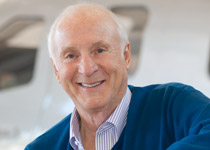Retired TWA captain Barry Schiff holds all seven instructor ratings.
AOPA inaugurated Project Pilot in 1994. This program was designed to encourage members to nominate as potential pilots persons they know who have the inclination, maturity, and means to undertake flight training. Such members would act as mentors — not instructors — and offer support and encouragement during the flight-training period.
The ultimate purpose of Project Pilot was and still is to bolster interest in general aviation. In 1980, there were 827,071 active pilots, but in the year before Project Pilot, there were only 665,069 pilots, almost a 20-percent decline. Project Pilot has helped to stem the tide such that the pilot population is now stable. (It is a tribute to AOPA's leadership that membership recently topped 400,000 at a time when the pilot population is flat.)
AOPA President Phil Boyer invited me to serve as the national mentor during the first full year of Project Pilot. I accepted eagerly because it would give me a unique opportunity to return to aviation some of what aviation has given to me.
I did not have a mentor when I began flying as a 14-year-old in 1952. My parents were adamantly opposed to their oldest son learning to fly. They wanted me to become a doctor or a lawyer. I forged my mother's signature on my application for a student pilot certificate and worked during every spare hour to accumulate the coins needed to buy flying time. In 1952, an hour of dual instruction in an Aeronca Champion cost $11. Sound inexpensive? At that time, I had to work 22 hours to earn that much money. It was not until I was hired by TWA in 1964 as a "Connie" copilot that I ultimately gained my parents' approval.
I did have a mentor, though, but I did not meet him until after I got my private pilot certificate in 1955 and was working on the line at Bell Air Service at the Santa Monica airport in California. Paul Blackman kept his North American Navion there, and my relationship with that magnificent machine consisted only of towing it in and out of the community hangar, pumping fuel into the wing tanks, and cleaning the windshield. To me, there was nothing more alluring in the world than that immaculate Navion (N5227K). Its sleek lines and sliding canopy reminded me of the airplane after which it had been designed, the North American P-51. (This would be as close as I would get to flying a Mustang.)
Blackman had been a bomber pilot during World War II and afterward became an executive in the meat-packing business.
"Barry," he asked one day, "if I checked you out in my Navion, would you fly one of my cattle buyers to Visalia this weekend?" It was a rhetorical question, and Blackman knew it.
Transitioning from an Aeronca Champ to a Navion was a giant leap. This was a big, heavy airplane. It had a hydraulic system and a panel so loaded with gadgets that it made me feel as though I were in the cockpit of an airliner.
After some maneuvering, Blackman had me level off at 7,500 feet over the Los Angeles Basin. During that smooth, rock-solid flight, he turned to me and said that he thought I could hold 7,500 feet just as easily as I was holding 7,600. Blackman had no tolerance for sloppiness.
During a subsequent flight, he feigned sleeping in the right seat, and every once in a while would blurt out, "I felt that." Blackman had golden hands, and he expected others to manipulate the controls with equal finesse. "You should never feel what a pilot does with an airplane," he would teach. "There's nothing we can do about a gust knocking down a wing, but raising the wing doesn't have to be matched by the pilot with equal vigor. It's not how quickly you restore attitude as long as you get it moving in the right direction."
Blackman taught me a great deal about flying and patiently nurtured and molded me into a decent pilot.
That weekend I flew Blackman's cattle buyer to Visalia. His name was Harry Abdul. Eight years later, he and his wife would have a baby girl who eventually became famous as song-and-dance sensation Paula Abdul. Little did Harry know that his 17-year-old pilot had only 120 hours in rag-covered, taildragging trainers and was commanding the Navion for the first time.
Blackman taught me that a pilot performs best when you show confidence in him, something that some airline captains do not seem to understand. During my years as a co-pilot for TWA, I discovered that captains with the most confidence in their own abilities instilled the most confidence in their first officers; those not as confident have difficulty trusting the skills of their copilots.
As the years passed, Blackman's and my roles became transposed. He relied on me to provide him with advice during flight reviews and instrument proficiency checks. It seemed so strange teaching him techniques that he could not remember having taught me so very long ago.
Every pilot should have a mentor during the formative years of his flying career, someone to provide support and encouragement. A special gratification comes from helping someone to reach a goal. Blackman played no small role in helping me to reach mine, and I will be forever grateful. Thanks, Paul.
Visit the author's Web site ( www.barryschiff.com).



